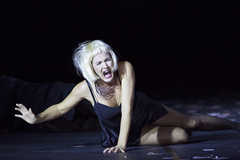| Opera Reviews | 5 May 2024 |
Minimalist and full of tension, but lacking in Verdian styleby Moore Parker |
|
| Verdi: La Traviata Theater an der Wien 1 July 2014 |
|
|
The work was performed without an interval (in itself an interesting option when scene changes are no issue), and lasted exactly two hours. With the lack of sets, costumes and wigs serve prominently for effect: Violetta begins with a black pageboy look, to move to her natural strawberry blond for Act II’s country scene, then on to platinum for Flora’s party, before returning to the color of her happiest moments before her demise. In the Act I opening a combination of red, black, and white - with the Arnold Schoenberg Choir (excellent as usual) looking dazzlingly elegant (costumes and props, Johannes Leiacker) - contrasts with Alfredo who appears in duffle coat, cords, and cardigan. An evident bookworm, he recites his lines ("Libiam ne’ lieti calici…"), and again later from the front stalls in his interceptions during “Sempre libera”, shyly blearing at Violetta through his heavy-framed spectacles. This production seethes with tension - and indeed aggression -from beginning to end. Violetta is ill-tempered with her guests, who too appear prepared more for battle than their beds as they depart the soirée, and the mood laps over again and again – as much in the musical as in the staging aspect. Notably avoiding any hint of sentimentalism or emotional warmth, the scheme alas fails to present the spectrum of Verdi’s great score and often risks compromising the protagonists into monochrome, hectoring figures. Sian Edwards’ reading in the pit (with the ORF Radio Symphony Orchestra) is at it’s best in the larger numbers. Too often, the composer’s plain and apparently simple accompaniments in solos and duets come across as banal and impotent, lacking life-awakening subtlety. Marlis Petersen’s soft-grained and appealing soprano profits in Violetta’s lyrical moments above all (“Ah, fors’e lui che l’anima” and in “Addio, del passato…”, for example). Her essentially non-Italianate timbre and lack of tonal variety fail to be compensated by dazzling scale work, dynamic spectrum, or a stunning top (even the Act I Cs are precarious, and the optional E natural in “Sempre libera” remains unattempted) – all leaving an attractive stage presence and dramatic commitment to carry the performance. Arturo Chacón-Cruz somewhat reminds (regrettably) of the young Rolando Villazón – intense, with a fine lyric tenor to hand. Alas, his Alfredo verges on frenetic throughout the evening, bent on showing voice rather than vocal style – not to mention Verdian style. For the record, the one verse of the cabaletta to “De’ miei bollenti spiriti” was included - in the original key. Disappointingly brutish, Roberto Frontali’s Germont père bears no resemblance to his recent finely-spun Michonnet in the Vienna State Opera's Adriana Lecouvreuer. Foursquare lines (though his “Di Provenza il mar” won the best applause of the evening) and an unrelentingly hectoring timbre left no doubt as to the character's steel backbone - but served Verdi little purpose. Flora’s party is cleverly worked with the guests continuously crossing the stage in several rows while throwing playing cards in the air. The Act III prelude is used to empty the stage, leaving Violetta alone on the floor for the final scene. Of the supports, Igor Bakan was a characterful and unsympathetic Dr. Grenvil, and Gaia Petrone created a lovely cameo out of the rather thankless Annina. The entire team met with a positive reception at the final curtain. This is a co-production with Opernhaus Graz and English National Opera.
|
|
| Text ©
Moore Parker Photo © Werner Kmetitsch |

 Minimalist in every sense of the word, without sets and comprising one coffee house chair, a deck of playing cards and a stack of books as props, not to forget one small pistol (drawn by Violetta in Act II with Germont père) - Peter Konwitschny's take on La Traviata meanders between sets of curtains, real and imaginary which are drawn to and fro - opening and closing the road to the developments in the plot.
Minimalist in every sense of the word, without sets and comprising one coffee house chair, a deck of playing cards and a stack of books as props, not to forget one small pistol (drawn by Violetta in Act II with Germont père) - Peter Konwitschny's take on La Traviata meanders between sets of curtains, real and imaginary which are drawn to and fro - opening and closing the road to the developments in the plot. 





